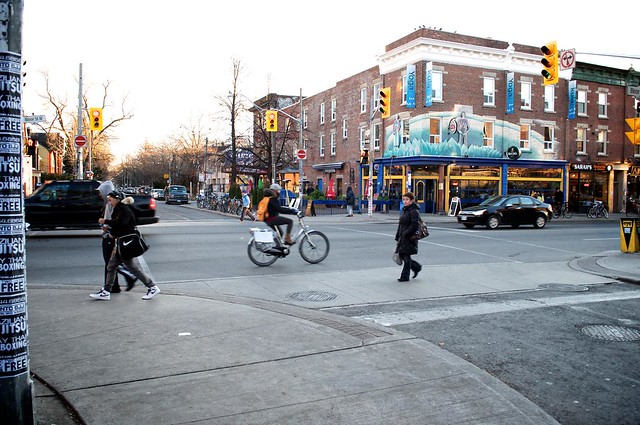
The intersection of Bloor and Brunswick is a popular nighttime destination for many Torontonians, offering enough pints and pitchers to make it hard to remember a night out, let alone appreciate the historic setting of it. That said, some Brunswick locals would be happy enough just to have this revelrous crowd remember that their stumble home is cutting through a residential area, while the endangered Tranzac is pleading for locals to appreciate it while they still can.
Brunswick Avenue’s name is most likely derived from Caroline Brunswick, who was the wife of King George IV and the daughter of Charles William, Duke of Brunswick-Wolfenbüttel. Notably, although King George found his wife unattractive and intolerable, she maintained a fair deal of popularity with the British public. King George sought a divorce bill that was eventually defeated, and he instead resorted to paying Caroline an allowance for her to exile herself elsewhere in Europe.
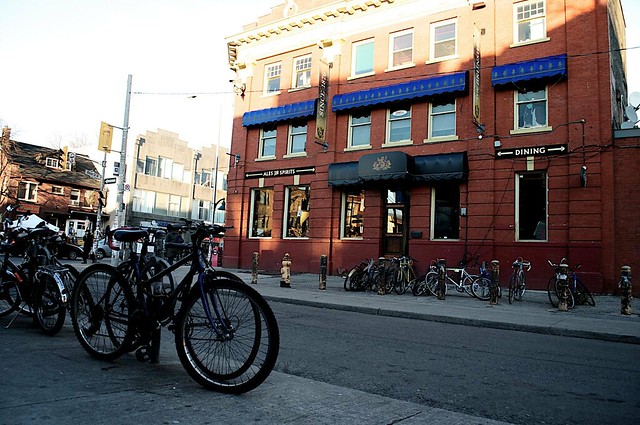
While Brunswick’s name can thus be traced back to the House of Brunswick, the street’s development really began with “Ye Olde Brunswick House.” As part of the area around Bloor and Bathurst, Brunswick Avenue in the mid-1800s fell into what was known as “The Bush,” named for its sparse population. The street’s development received a jumpstart with George T. Davies’ 1876 construction of a stagecoach stop. In the 1950s, Davies’ hotel was rechristened “the Brunswick” or “the Brunny” by a loyal following of nearby University of Toronto undergraduates, who also began to populate the Annex. The Brunswick was bought by Morris and Albert Nightingale in 1961, and went on to become one of the city’s flagship bars. In the 1970s, it inherited a jazz and blues crowd when Yonge Street’s Colonial Tavern closed, and the Brunswick expanded with a new addition: Albert’s Hall. In his book Toronto: tales of the city, Glen Cochrane covers both the Brunswick’s history and a number of its famous characters: “The Queen of Sweden,” renowned for her dance routines; “Diamond Lil Sheperd,” a singing waitress; and Toronto Sun columnist Paul Rimstead, who used the Brunswick House as the headquarters for his 1972 “mayoral campaign.” Of course, these were only the more infamous of the Brunswick’s clientele; Cochrane goes on to say that “By 1980, the Brunswick’s beer sales were among the highest in the province.”
That said, Naomi Lightman’s 2005 feature “The Brunny Grows Up” in Eye Weekly (posted online on Tribe’s forums) noted that the Brunswick House also came to develop a lengthy police record – 155 police calls betwen 1998-1999. Thus, when current owner Abbis Mahmoud bought the bar in 2005, he sought to refocus it as a “family-friendly restaurant” during the day, and to tame the evening’s student crowd with soundproof walls. Mahmoud even considered changing the bar’s name to escape the Brunny’s “bad reputation,” but former patrons contended that this past was a “legacy.” In the end, Ye Olde Brunswick House lives on, trying to strike a balance between food and fun.
Toronto’s writers are another group with a storied relationship with Brunswick Avenue. Indeed, Katherine Govier’s collection of short stories Fables of Brunswick Avenue is set on the street and opens with the line “Everyone lives on Brunswick Avenue sooner or later.” The statement holds true among Govier’s literary peers – in Toronto: The Unknown City, Howard Akler and Sarah Hood trace authors Dennis Lee, Marian Engel and Morley Callaghan through their own stints on Brunswick Avenue. Noah Richler also offers further background on Govier’s experience on Brunswick in This Is My Country, What’s Yours?: A Literary Atlas of Canada. He situates Richler’s book in Canadian Literature’s “Age of Mapping,” exploring its role in Canada, Toronto and Brunswick Avenue’s self-discovery.
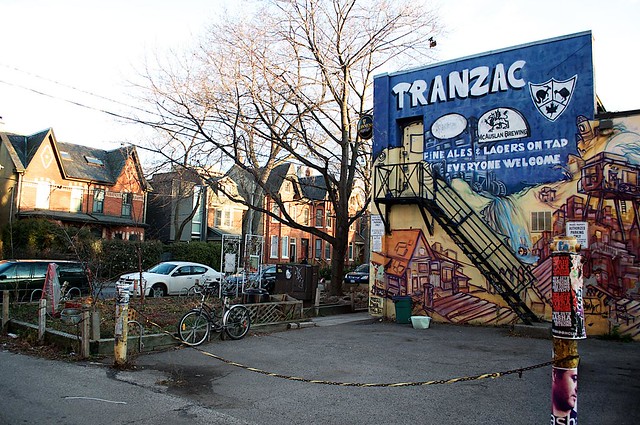
Brunswick Avenue is also significant for the role it has come to play in many musical careers. Local organization the TRANZAC – Toronto Australia New Zealand Club – seeks to marry Toronto with the land down under, and promote Australian and New Zealand culture. Its home, the Tranzac venue, also hosts a great number of art, theatre and live music shows. Shows play every Monday through Thursday with no cover charge, showcasing an array of up-and-comers. Indeed, rock outlet Spin Magazine selected the Tranzac alongside the Horseshoe, Sneaky Dee’s and Lee’s Palace in their 2008 profile of Toronto venues. Unfortunately, the Tranzac is struggling in the face of rising property taxes, new building expenditures, falling revenue, and the loss of the Fringe Festival to Mirvish Village. In light of the club’s uncertain future, club president Michael Booth made a point of reiterating the importance of the current venue on Brunswick Avenue in Torontoist’s recent feature on the Tranzac’s financial troubles. Thus, the Tranzac has asked Torontonians for their help in allowing it to continue its own journey into Brunswick and Toronto lore. As part of the club’s campaign, Ian Daffern produced a video “A Tribute to the Tranzac” that does a great job of illustrating the venue’s role in the Toronto community and giving a sense of a Tranzac concert. In the past couple of weeks, Torontoist has also ran an excellent series by Steve Miller, The Tranzac Transcripts, profiling musicians’ personal connections to the Tranzac. Interested readers can look into either donating or attending tonight’s fundraiser concert. With enough support, the Tranzac can hopefully grow from a “well-kept secret” to reassert its presence on Brunswick Avenue.
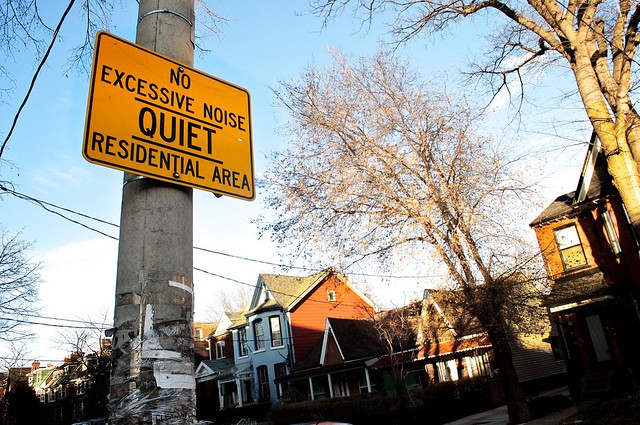
Mind you, the Tranzac’s pub peers on Brunswick Avenue are not without their own woes. For one thing, it’s obviously important to note that the Tranzac, the Annex Live, the Labryinth Lounge, Futures, and the Brunswick House are at the corner of a street full of Brunswick houses. Much was made of the tension between these establishments and the surrounding homes during 2009’s patio disputes. Eye Weekly’s coverage notes that, for his part, Adam Vaughn sought some degree of compromise between residents’ complaints and bar-owners’ business models, requiring extra patio security, reinforced noise barriers, and earlier hours. Indeed, a number of “Quiet – residential street” signs are in place along Brunswick Avenue to remind anyone stumbling home from a Thursday night out that there are people waking up for work the next morning. In fact, Torontoist’s feature on the Tranzac revealed that part of their increased expenses came from the added security costs associated with keeping noisy patrons inside. On the other end of things, Brunswick back-alley hotspot the Green Room has ceased operation altogether after failing its fourth health inspection in two years and losing its licence.
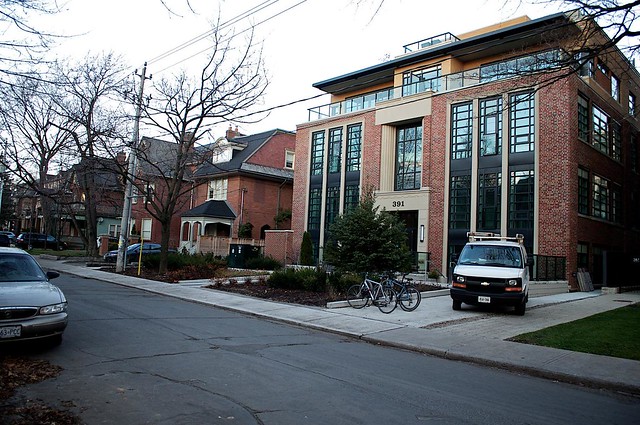
Meanwhile, the street’s housing market is thriving. As the Annex has shifted away from a student ghetto into more of an upscale neighbourhood, Brunswick has also begun to reflect this shift. The street’s characteristic red brick houses are now joined by modern renovations and small-scale condo offerings. One notable new opening is Schoolhouse Lofts, a 19-unit conversion of the street’s former Loretto College. Building off of an old Annex building in this way has created a condo that actually fits very well with the streetscape, even featuring some red brick of its own.
Another interesting development for those who live along Brunswick is the renovation of Sally Bird Park, which has seen the existing playground replaced with adult exercise equipment at the request of a local resident consult. CELOS (The Centre for Local Research into Public Space) offers a gallery of the park in its previous incarnation, while Jake Tobin Garrett covered the new exercise equipment on his blog Deconstructed City. The renovation is part of the Recreational Infrastructure Canada Program, jointly funded by all three levels of government.
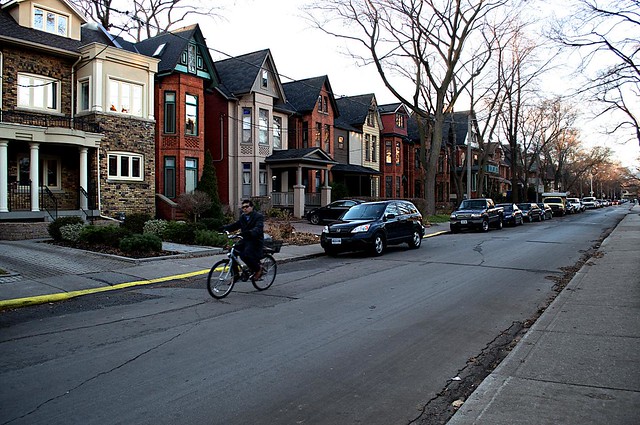
Like a rowdy bar patron, Brunswick Avenue’s eponymous pub and other nightlife institutions can sometimes overshadow their company – generating disruptive volume, or obscuring the Tranzac’s own compelling cultural draws. Nonetheless, there’s much to appreciate along Brunswick – its homes have housed great writers, its bars have bred great characters, and the Tranzac has cultivated great talent. I’ll toast to that.
More photos of Brunswick Avenue can be seen in our Flickr set.
Street Stories is a regular feature profiling the origins, development and current state of Toronto streets. For more background on the history of Brunswick Avenue and other Toronto streets, we recommend the excellent book Toronto Street Names. If you have an idea for a street we should feature in an upcoming instalment, email ericmutrie@spacing.ca.

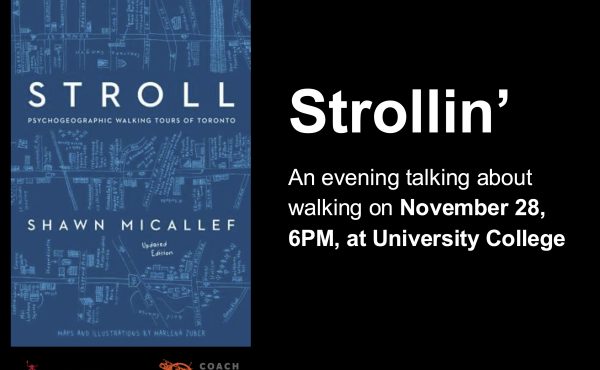


12 comments
Substantial, well-researched and well-written article. I’ve learned much about a street I barely noticed before. Great photos to enhance the story. Thank you!
“While the previous three years had been relatively stable for the arts and culture hub, tucked away just south of the busy corner of Bloor and Brunswick, from June 2009 to June 2010, the not-for-profit club saw its property taxes rise by more than half due to a (still contested) assessment that doubled the building’s value on paper;”
The Torontoist article highlights the point that I continually make. Namely that property taxes are going to destroy small commercial spaces throughout the city. Once the CVA capping protection expires. Add to that the HIghest and Best use methodology used by MPAC and tax burdens will rise to levels far greater than gross rents can generate. In turn this will pressure the redevlopment of such properties into more residential. You can say goodbye to Kensignton Market,The Beach, West Queen West, Ossington, etc.
Thanks for a great article!
“That said, Eye Weekly’s 2005 feature “The Brunny Grows Up” (unfortunately not available online)”
It IS available online: http://bit.ly/e18dbG
I appreciate the find, YYZGIRL! I’ve corrected the article with your link.
Nice article, but no mention of the Narayever Synagogue on Brunswick just north of Harbord…. it is one of the few functioning synagogues left in a neighbourhood that used to be heavily Jewish, and is built in a simple but beautiful style. It has an interesting history of its own — dates from an era (now long gone) when small synagogues tucked into residential neighbourhoods were common.
Glen: have you heard that Ford won’t rule out raising commercial taxes even while he’s promised a residential freeze?
I did hear rumours to that sort. I doubt it will happen though. They would need permission form the province to do so because that would increase the ratio between properties.
And you’re so blase about it? You’re not railing against the thought of it? That’s your guy in office really quiets you down that much?
Once the anti-fun AGCO Taliban have successfully regulated Tranzac out of existence, can we expect a 30 storey condo proposal? Reduced to 24 storeys in order to appease the ‘planners’ of course.
Here’s another little tidbit about Brunswick: Ernest Jones used to live at 407 Brunswick. Jones was a good friend of Sigmund Freud and anyone who studies Freud usually includes the “Freud-Jones correspondence letters.”
Here are a couple letters with the address:
http://www.pep-web.org/document.php?id=zbk.028.0104a
http://www.pep-web.org/document.php?id=zbk.028.0127a
Jones lived in this house with his sister and another woman, reportedly his mistress. Some speculate that this “other woman” was actually his sister’s lover. Jones hated Toronto while here in the 1910s – he found it far too conservative and, though teaching at U of T, couldn’t get an audience for his rather radical theories about sex and sexuality.
407 Brunswick has just been converted into a duplex. It was interesting to see the architectural rendering posted on the fence during construction: it showed the original structure shaded with the new additions… there’s a joke in there about the persistence of the id!
Street View: http://goo.gl/e6N0y
I won’t be blase about it if it is true.
I don’t think any discussion of Brunswick is complete without mentioning its role in Toronto’s queer history: http://en.wikipedia.org/wiki/Brunswick_Four